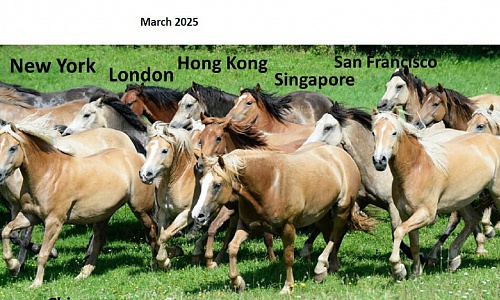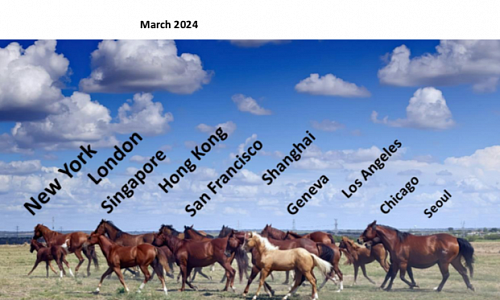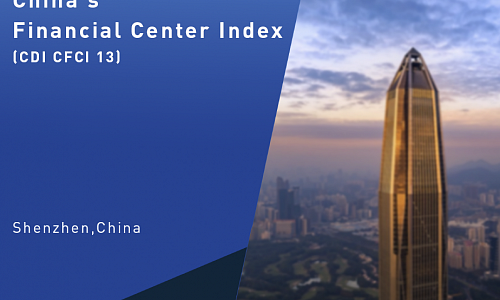Shaanxi's Xixian New Area Project Explores Innovative Model of Urban Development
XI'AN, China, Oct. 19, 2018 /PRNewswire/ -- The first Xixian New Area International Forum on Innovative Urban Development Mode (IUDM 2018), organized in Xi'an and attracting more than 500 experts and scholars from China and abroad to explore innovative urban development models, was held under the theme "New Era, New Economy, New City."
The forum was joined by Rajendra Kumar Pachauri, former chairman of the Intergovernmental Panel on Climate Change (IPCC) from 2002 to 2015; Liu Shijin, deputy director of CPPCC Committee for Economic Affairs and former vice-president of Development Research Center of the State Council; and Fan Gang, secretary-general of the China Reform Foundation and director of the National Economic Research Institute.
The IUDM 2018 placed special focus on urban development principles including city quality, living environment and applications of new technology through themed exhibitions, keynote presentations and public engagement activities. Xixian, the host district and the latest result of innovative urban development in the region, has been highlighted as a solution for future urban planning and management.
As the newest district of the greater Xi'an area, Xixian contributes to the development of urban planning through a focus on the construction of national-level free trade pilot zones, service trade zones and innovation and entrepreneurship zones as a means of boosting Shaanxi's economic growth and credentials as a hub for emerging strategic industries and services.
"Hoping to create a sample of new urbanization with Chinese characteristics, we insisted on a people-centred urban development strategy that conserves resources, preserves the environment, matches urban to rural development and protects historical and cultural heritage. Through years of tireless explorations, the result is gradually coming together," said the vice-governor of Shaanxi Province at the forum.
"Xixian New Area has entered a period of accelerated development, the IUDM 2018 forum is a new starting point, and we cordially welcome everyone to come to Shaanxi and Xixian and join us to write a magnificent new chapter of the future for urban development," said Liang.
For more information, please visit: http://en.xixianxinqu.gov.cn/
About Xixian New Area
The Xixian New Area is the first national new area themed with innovative urban development mode. It is led by innovative urban planning and city-industry integration with ecological priorities; the goal is to create a modern, sustainable city with improved ecology, livability and business environment.
SOURCE Xixian New Area
China Real Estate May Face ‘Year of Recession’
After years of booming growth, China’s real estate sector, a major pillar of the world’s second-largest economy, is wobbling.
The fundamentals of China’s real estate market will face “a year of recession” in 2019, China International Capital Corp. (CICC) said Monday in a research report. Sales, investments and new construction starts will decline significantly next year, according to researchers at the largest state-backed investment bank in China. In response, the government should alter policies that were put in place to cool the market, the researchers said.
The assessment reflects the chill in the market that Chinese property developers have already begun to feel, prompting them to dial back land purchases. Growth in China’s real estate investment slowed to 8.9% in September from 9.2% in August, and home sales by floor area fell 3.6% from a year earlier, the first time since April.
During the ordinarily golden September-October property-sales season, slack demand forced developers to offer huge promotions, including free cars and lower down payments. Some developers slashed prices as much as 30%, angering earlier buyers who paid higher prices.
The central government initiated a campaign to control surging property prices in September 2016. Based on previous cycles, policymakers usually begin to relax tightening measures after housing sales have declined for six months. Based on that, CICC projected that the next round of policy easing may come at the end of the 2019 first quarter or the start of the second quarter.
But as China’s economy faces broader headwinds and uncertainty from an intensifying trade war with the United States, CICC’s researchers recommend an earlier policy adjustment. China’s top financial and economic officials haven’t addressed the cooling outlook for the property market.
According to the CICC assessment, property sales across China are likely to fall for the first time in five years, with sales by floor area and by prices both expected to decline 10%. The downward pressure on home sales and prices will be especially obvious in third- and fourth-tier cities, while the property market in the first- and second-tier cities is expected to be resilient.
CICC said it expects real estate investments in 2019 to decline by 5% and new construction starts, by 10%, reflecting weakening fundamentals in the property industry.
China Vanke Co. Ltd., one the country’s biggest developers, recently said "survival" was the ultimate goal for the next three years as a “turning point” has arrived for the industry.
The Mid-Autumn festival and the week-long National Day holiday normally bring buyers out in masses in September and October, spurring residential property sales. But this year has been different, even for the country's biggest developers.
During the weeklong public holiday at the start of October, sales in 31 cities fell 27% from a year earlier, according to Shanghai-based property consultant CRIC.
Several major Chinese property developers significantly slowed their land purchases in September.
A total of 2,332 plots of land, with a gross area of 97.3 million square meters, were available for sale in September, according to a China Index Academy report. That was an 8% decrease year-on-year. A total of 1,950 plots were sold, down 13% compared with the same period last year.
The CICC report suggests four feasible paths for policy adjustment next year, including increasing supply, lowering the down payment ratio, relaxing excessive restrictions on mortgage interest rates and increasing the amount of mortgage loans.
Measures to control housing prices could be maintained, but pricing mechanisms and price tracking management should be improved, the researchers suggest.
On the outlook for property stocks, CICC said it thinks the P/E ratios of mainland listed A stocks and Hong Kong-listed H stocks are at a historic low level. Even though a sales decline will raise concerns about property developers’ sales and profit growth in the short term, the negative effects are likely to be far less than the boost expected from policy adjustment, the bank said.
A fishing village becomes an economic juggernaut
City transformed from traditional model to major hub of innovation
Four decades ago, Shenzhen was just a small fishing village adjacent to Hong Kong. Today, the city in southern Guangdong province is the country's high-tech and innovation hub.
It's known as China's Silicon Valley and is the headquarters of internet and telecom giants Tencent and Huawei, thanks to the country's reform and opening-up policy.
With a population of more than 12 million, Shenzhen's rapid growth arose from cultivating emerging industries, including the internet, new-generation information technology, new materials, new energy and biological medicine. Beyond that, energy conservation, environmental protection and the cultural and creative industries have played a key role.
Last year, the added value of emerging industries in Shenzhen amounted to about 918 billion yuan ($132 billion), increasing 13.6 percent compared with a year earlier and accounting for 40.9 percent of the city's GDP, according to official statistics.
The bioindustry saw the most robust growth, with added value expanding 24.6 percent year-on-year, followed by the internet industry at 23.4 percent.
The metropolis is now home to more than 11,000 national high-tech enterprises.
"Shenzhen's high-tech industry has already formed an integral industry chain. It has an internationalized supporting system at its back," said Huang Dinglong, chief executive of artificial intelligence company Malong Technologies.
The local government has attached great importance to research and development. Last year, Shenzhen's investment in R&D reached over 90 billion yuan, accounting for 4.13 percent of its GDP, on par with Israel and South Korea, which lead in that category.
Local policies have provided a sound breeding ground, allowing high-tech enterprises to grow in a sound environment, said Yan Qin, general manager of Direct Genomics, a company specializing in genomics.
"They don't have an extra burden, as the local government offers great support to them - for example, helping them with initial funding and understanding government policies."
In addition, with its proximity to the international financial center of Hong Kong, Shenzhen has also developed strengths in capital, with a large number of small enterprises being able to secure venture capital at early stages, Yan added.
Over the 40 years since the reform and opening-up policy was launched, Shenzhen has been an economic miracle by global standards, with its GDP growing at more than 20 percent a year on average.
In 1980, it was chosen as China's special economic zone, which entitled it to more market-oriented and flexible economic policies.
Since then, Shenzhen's economy has seen explosive expansion, from under 200 million yuan to 2.2 trillion yuan in 2017, which is more than 10,000 times bigger and on course to surpass Hong Kong.
Qu Jian, vice-president of the China Development Institute, said the city has transformed from a traditional economy reliant on resources and labor to a modern economy fueled by innovation.
"The reason so many technologically innovative enterprises have been created in Silicon Valley is that talent across the world is flocking into the area," Huang said. "It's the same for Shenzhen."
Yan, meanwhile, said local high-tech enterprises have a shortage of professional managers, who he believes play a vital role.
"Shenzhen needs to introduce more professional managers who have worked at Fortune 500 companies to improve management so that the city's high-tech industry can achieve better growth,"
Trade war has accelerated China's liberalisation of economy, says Chinese government adviser
BANGKOK - China is serious about liberalising its economy and its pace of doing so has been accelerated by its trade war with the United States, says Chinese economist and government adviser Fan Gang.
"That kind of willingness is genuine… China recognises that it needs more liberalisation to become more competitive in the global market," said the Peking University professor and president of Shenzhen-based think-tank China Development Institute.
But the pace of reforms has been hampered by what he called "vast interest groups" lobbying Beijing against lifting the protection for local firms that it has maintained for years as a developing country.
"China should move on. You have more and more companies operating internationally and enjoying international terms for competition. Why do you still have those protections?... More and more companies don't need it," Professor Fan said, referring to Chinese companies like mobile phone maker Huawei.
"Previously, China's pressure came from the top. The policymakers put pressure on the localities, on the companies, to push them to change," he said. Now, "some outside pressure may serve as a good push".
Prof Fan was speaking to The Straits Times on Tuesday (Oct 30) on the sidelines of the Forbes Global CEO Conference in Bangkok.
Global stock markets have taken a bumpy ride this year after US President Donald Trump triggered a trade war between the world's two largest economies, accusing China of stealing intellectual property and unfair trade barriers.
A series of tit-for-tat measures has resulted in more than US$250 billion (S$346 billion) worth of Chinese goods subject to tariffs of up to 25 per cent in the US, and some US$110 billion worth of US goods are subject to reciprocal taxes in China.
Analysts expect the trade war to put a drag on global economic growth.
Mr Trump and Chinese President Xi Jinping are expected to meet on the sidelines of the Group of 20 (G-20) summit in Buenos Aires next month.
Mr Trump, while saying he expects to make a "great deal" with China, has warned that he is ready to slap tariffs on even more products if a deal does not transpire.
In the face of the trade war, China should focus on developing its own market rather than retaliation, said Prof Fan.
"As long as you can really extend your market further, as long as you can attract more investment in your industrial supply chain, you can win," he said.
Asked if he was concerned that companies which export products to the US may relocate from China to third countries, Prof Fan said that was "unavoidable".
The flip side of this is that companies targeting the Chinese market may be nudged to set up base within China to avoid the tariffs, he added.
Given the complexity of modern supply chain networks, it is too early to say which country will ultimately prevail, he cautioned.
"That depends on which market is growing faster… which becomes bigger," he said. "If the China market is growing faster and becomes bigger, China may not suffer too much."
Talking their way out of the China-US trade war
A fierce debate is raging about the future of China’s economy. Many believe it is being held behind closed doors at the powerful Politburo.
They would be wrong. Instead, these discussions are taking place in the hallow halls of Peking University.
In the past three weeks, Zhang Weiying, the prominent liberal economist and a professor at the prestigious seat of learning in Beijing, has mapped out his vision of the future.
On Monday, Fan Gang, another influential professor at Peking University and president of the China Development Institute, outlined a similar roadmap.
Their views come at a time when the world’s second-largest economy is being buffeted by internal and external headwinds, including rising trade tensions with the United States.
Zhang has attributed the Cold War-style stand-off between Beijing and Washington to China’s flawed economic model.
“Domestically, misleading yourself means a future of self-destruction,” he said in a speech, which appeared on the National School of Development’s website before it was taken down by the authorities.
“Blindly emphasizing the unique Chinese model means going down the road of strengthening state-owned enterprises, expanding government power, and relying on industrial policy. This will lead to a reversal of the reform process, the abandonment of our predecessors’ great cause of reform, and ultimately economic stagnation,” he continued.
“Externally, misleading the world leads to confrontation. From the Western perspective, the ‘China model’ theory makes China into an alarming outlier, and must lead to conflict between China and the Western world,” Zhang added.
During the past six months, international relations with the West have deteriorated as quickly as the economy.
Threatened
Tariffs worth more than US$250 billion have already been slapped on Chinese exports to the US by President Donald Trump.
He has also threatened to impose duties on the remaining goods and products worth another $258 billion, citing “unfair practices” and “intellectual property violations.”
Moreover, the fallout has rippled across the entire economy with GDP growth falling to levels not seen since the Great Recession of 2009, while consumer spending has slowed and factory activity has dropped.
“China is serious about liberalizing its economy and its pace of doing so has been accelerated by the trade war with the United States,” Fan, who is also an adviser for President Xi Jinping’s government, said.
“That kind of willingness is genuine … China recognizes that it needs more liberalization to become more competitive in the global market.”
But the pace of reforms is in danger of stalling with “vast interest groups” lobbying against further opening up to overseas competition.
This, he pointed out, had to change as China’s economy goes through a transformation from low-cost manufacturing to high-tech production, backed up by a thriving services industry and a more sophisticated consumer sector.
“China should move on,” Fan said. “You have more and more companies operating internationally and enjoying international terms for competition. Why do you still have those protections? More and more companies don’t need it.
“Previously, China’s pressure came from the top. The policymakers put pressure on the localities, on the companies, to push them to change. [Now,] some outside pressure [such as the trade dispute] may serve as a good push.”
Realigning the economy and being embroiled in a brawl with the US has prompted the Politburo, which is the main decision-making body of the ruling Communist Party, to reiterate its pledge to stimulate growth.
So far, the government has unveiled a raft of measures, including tax cuts, infrastructure spending and cheap financing for struggling private sector companies, while pressing ahead with its clampdown on debt.
A stimulus-inspired package for the markets has also been rolled out after nearly $3 trillion was wiped off the Shanghai Composite Index and $1.1 trillion off Shenzhen in the past nine months. This, in turn, has hit the spending power of more than 150 million middle-class investors.
Priority
Boosting confidence has become a priority with the Politburo admitting on Wednesday that “downward pressure on the economy has increased” and that “timely measures” must be taken, without revealing concrete proposals.
Hours later, Chinese factory activity statistics for small- and medium-sized companies were released.
The numbers were disappointing with the Caixin Purchasing Managers’ Index, or PMI, edging up slightly higher to 50.1 from 50.0 in September while remaining in expansion territory.
“China’s economy has not seen obvious improvement,” Zhengsheng Zhong, the director of macroeconomic analysis at CEBM Group, a Caixin subsidiary, said.
“Overall, expansion across the manufacturing sector was still weak. Production and business confidence continued to cool despite stable demand. The pressure on production costs didn’t ease,” he added.
Roughly 24 hours earlier, the official PMI, compiled by National Bureau of Statistics, revealed that manufacturing growth was at its weakest level in more than two years, fueling concerns about the aftershocks of tit-for-tat tariffs and a perceived slowdown in major reforms.
“China’s reform and opening-up and the China-US strategic cooperation are two inter-related things,” Sheng Hong, the executive director of the Unirule Institute, an independent Chinese think tank, said. “That is to say, there is no strategic cooperation without reform and opening-up, nor is there reform and opening up without China-US strategic cooperation.
“Today, China faces the risk of leaving the path of reform and opening up, which would risk the loss of strategic cooperative relations with the US. Such a result would be a complete failure.”
Amid the carnage of the trade battle, the great China debate continues.
No quick fix to US-China trade war – even with a Trump-Xi meeting, top Beijing economic adviser says
Beijing and Washington are unlikely to reach a deal on intellectual property rights or further opening up of China’s financial market – even if the leaders of the two countries meet later this month, a key Chinese government adviser said.
“What they were negotiating in Beijing and Washington in the past round [of talks earlier this year] was mostly about trade itself,” Fan Gang, a former member of the monetary policy committee of the People’s Bank of China, said in a speech at Harvard University on Wednesday.
Since the countries had not even begun to discuss the two issues at the heart of the trade war, it was “hard to have a solution” to the dispute, Fan said.
When asked whether China would improve its intellectual property protection and further open up its financial market to ease trade tensions with Washington, Fan said the reforms were necessary but would not come quickly.
“The reforms may change the position of the other side, but it will take some time. It’s not a short-term issue. It’s a midterm issue,” Fan said.
Chinese President Xi Jinping is expected to meet his US counterpart Donald Trump on the sidelines of the G20 summit in Buenos Aires at the end of this month.
They are not talking about trade … Buying doesn’t solve the problem
Fan Gang
Analysts on both sides have expressed confidence recently that Beijing and Washington might reach a truce over the trade dispute during the summit, in the two leaders’ first meeting since a tit-for-tat trade war between their nations broke out in July.
But Fan, a leader in an economists’ club founded by Chinese Vice-Premier Liu He, said he was pessimistic about bilateral ties “in the short-run and the long run”. Liu had led several rounds of trade negotiations this year with Trump administration officials including Treasury Secretary Steven Mnuchin.
“I don’t think in the short-run you can reach an agreement,” Fan said. “How can you reach agreements with Donald Trump and his team? They are not talking about trade. How much can China actually buy? Buying doesn’t solve the problem.”
The economist said he expected the ideological conflicts from the trade war to last.
“It’s about internet control, it’s about ideology, it’s about national security and so-called political superiority,” he said. “In the long run, it’s hard to have a solution.”
I think the United States is united on China
Fan Gang
Fan also acknowledged the consensus on China’s trade practice across the US political spectrum.
“It was the [US midterm] election day yesterday and anything seems to be a controversy, but I think the United States is united on China,” he said.
His comments came as Washington continued to express concern about China’s ambitious manufacturing plan, “Made in China 2025”, which channels state funds to domestic companies developing advanced technologies in robotics, telecommunications and aviation.
The initiative, which aims to break China’s reliance on foreign technology and pull its hi-tech industries up to Western levels, has become a lightning rod for Washington’s – and Trump’s – ire in the trade war with Beijing.
In a post-midterm-election address on Wednesday, Trump called Made in China 2025 “insulting” and suggested Beijing was backing away from it.
Fan stressed that continuing the initiative was beyond question.
Nevertheless, his views reflected a school of thought within Beijing that boldly favours China and the United States reaching a compromise to reduce the intensity of the trade tensions. He said the trade war had accelerated China’s long-needed market reform.
“There are so many things that the Chinese central leadership has agreed to do, committed to doing, but didn’t do for such a long time,” Fan said. “After the trade war, a lot of things started moving.”
No quick fix to US-China trade war – even with a Trump-Xi meeting, top Beijing economic adviser says
Beijing and Washington are unlikely to reach a deal on intellectual property rights or further opening up of China’s financial market – even if the leaders of the two countries meet later this month, a key Chinese government adviser said.
“What they were negotiating in Beijing and Washington in the past round [of talks earlier this year] was mostly about trade itself,” Fan Gang, a former member of the monetary policy committee of the People’s Bank of China, said in a speech at Harvard University on Wednesday.
Since the countries had not even begun to discuss the two issues at the heart of the trade war, it was “hard to have a solution” to the dispute, Fan said.
When asked whether China would improve its intellectual property protection and further open up its financial market to ease trade tensions with Washington, Fan said the reforms were necessary but would not come quickly.
“The reforms may change the position of the other side, but it will take some time. It’s not a short-term issue. It’s a midterm issue,” Fan said.
Chinese President Xi Jinping is expected to meet his US counterpart Donald Trump on the sidelines of the G20 summit in Buenos Aires at the end of this month.
Analysts on both sides have expressed confidence recently that Beijing and Washington might reach a truce over the trade dispute during the summit, in the two leaders’ first meeting since a tit-for-tat trade war between their nations broke out in July.
But Fan, a leader in an economists’ club founded by Chinese Vice-Premier Liu He, said he was pessimistic about bilateral ties “in the short-run and the long run”. Liu had led several rounds of trade negotiations this year with Trump administration officials including Treasury Secretary Steven Mnuchin.
“I don’t think in the short-run you can reach an agreement,” Fan said. “How can you reach agreements with Donald Trump and his team? They are not talking about trade. How much can China actually buy? Buying doesn’t solve the problem.”
The economist said he expected the ideological conflicts from the trade war to last.
“It’s about internet control, it’s about ideology, it’s about national security and so-called political superiority,” he said. “In the long run, it’s hard to have a solution.”
Fan also acknowledged the consensus on China’s trade practice across the US political spectrum.
“It was the [US midterm] election day yesterday and anything seems to be a controversy, but I think the United States is united on China,” he said.
His comments came as Washington continued to express concern about China’s ambitious manufacturing plan, “Made in China 2025”, which channels state funds to domestic companies developing advanced technologies in robotics, telecommunications and aviation.
The initiative, which aims to break China’s reliance on foreign technology and pull its hi-tech industries up to Western levels, has become a lightning rod for Washington’s – and Trump’s – ire in the trade war with Beijing.
In a post-midterm-election address on Wednesday, Trump called Made in China 2025 “insulting” and suggested Beijing was backing away from it.
Fan stressed that continuing the initiative was beyond question.
Nevertheless, his views reflected a school of thought within Beijing that boldly favours China and the United States reaching a compromise to reduce the intensity of the trade tensions. He said the trade war had accelerated China’s long-needed market reform.
“There are so many things that the Chinese central leadership has agreed to do, committed to doing, but didn’t do for such a long time,” Fan said. “After the trade war, a lot of things started moving.”
He cited China’s lifting of ownership limits for foreign car firms in April, which enticed US carmaker Tesla to build a plant in Shanghai; a further opening of the Chinese financial market; and lowering of tariffs as examples of trade war-impelled changes that have happened in recent months.
Other Washington policymakers, including Danny Russel, a former assistant secretary of state for East Asian and Pacific affairs, agreed that any deal between Trump and Xi at G20 would be limited or incremental if at all.
He said the Trump administration had publicly aired “such a list of offences by China, that are shared not only by the business community or the policy community but by Congress, that it may be hard for the administration to simply set those issues aside and say, ‘We’ve reached a deal on the trade figures, but we haven’t dealt with forced transfer of technology, of cybertheft, of intellectual policy, of the industrial policy of Made in China 2025’”.
Russel made his remarks at an Asia Society round table discussion in New York on Wednesday.
“If you don’t have a very clear direction of where to go, you confused the ministries and people who implement the policies,” Fan said of the central leadership’s shifting position on market reforms.
“You can’t blame all the problems on lower level bureaucrats,” he said. “That’s why I called the trade war a wake-up call.”
For China’s Polluted Megacities, a New Focus on Slashing Emissions
The northeastern fringes of Shenzhen — a fishing village that has been rapidly transformed into a global port city of at least 11 million people — are a patchwork of drab factories spewing smoke, and multi-lane highways packed with container trucks. The area epitomizes the severe pollution and runaway urbanization that have dogged southern Guangdong province since China’s ruling Communist Party began to embrace capitalism in the 1980s.
Yet one side road here leads to a jarringly different scene: A riverside plot landscaped with bamboo trees and elevated boardwalks and dotted with energy-efficient buildings that a state-run developer either built from scratch or refashioned from the shells of old factories. “It’s a demonstration of how we can live in a place without pollution and with clear air,” Cheng Fang, a spokeswoman for the developer, said on a recent afternoon at the eco-complex.
Over the last decade, China has taken ambitious steps to begin curbing its carbon footprint. In 2009 the powerful State Council announced a plan to reduce the carbon intensity of the national gross domestic product by 40 to 45 percent by 2020 compared with 2005 levels. And in 2014, President Xi Jinping pledged to peak China’s emissions around 2030 and increase the share of renewable energy sources in the economy from 8.3 percent in 2010 to roughly 20 percent by 2030. Both moves helped lay the groundwork for last year’s landmark climate agreement in Paris, which China and the United States formally ratified this month at the G20 gathering of heads of state in the Chinese city of Hangzhou.
A low-carbon pilot program now underway in 13 Chinese provinces and cities, including Shenzhen, is yet another sign of China’s carbon-cutting ambitions.
Under the program, which the National Development and Reform Commission launched in 2010, the municipalities have drafted policies that prioritize increasing the share of biogas and solar energy in the local energy supply, tightening fuel-economy and green-building standards, preserving urban green space, and prioritizing bicycles over cars in downtown areas, among other goals. Although specific outcomes are clouded by government propaganda and hard to measure objectively, the policies offer early glimpses of how China’s largest cities are beginning to rein in their emissions and create a more livable environment for their inhabitants.
Shenzhen’s sleek metro system now has an annual ridership nearly half that of New York’s subway system.
Among the 13 low-carbon pilot projects, Shenzhen is a leader for several reasons, according to sustainability experts who follow China’s urban development. Its carbon-trading scheme, which began in 2013, was China’s first and a precursor to a national program that is due to begin next year. Shenzhen also aims to have 80 percent of its new buildings green-certified by 2020, making it the most ambitious municipality in that sector among the pilot sites, according to a report by a U.S. Department of Energy laboratory. The city’s $18,812-per-user subsidy for electric vehicles — among China’s highest — has also incentivized the purchase of 8,000 electric vehicles since 2011. And by 2013, its sleek metro system, which opened in 2004, had an annual ridership of more than 777 million — nearly half that of New York City’s subway system.
These efforts are just a start for Shenzhen, which borders Hong Kong and is one of China’s richest cities. After adding at least 3,000 electric buses, 850 electric taxis, and 717 bike-rental stations in recent years, Shenzhen authorities plan to expand the metro system by 131 miles — more than twofold. They also plan to peak the city’s carbon emissions by 2022, eight years earlier than the national goal; significantly increase renewable energy production; and expand their carbon-trading scheme — which has focused on industrial companies and covers 38 percent of the city’s carbon dioxide emissions — to include vehicles. The carbon-trading program, which set an overall cap on carbon intensity and individual pollution targets, began in 2013 and has a transaction volume of $60 million. According to a compliance report by the International Emissions Trading Association, a Geneva-based non-profit that advises the Chinese government on carbon trading, greenhouse gas emissions from those industrial companies decreased by 3.75 million tons in the program’s first year, an 11.5 percent decrease compared with 2010 levels.
Setting up a system of carbon data collection and enforcement was expensive, says Liu Yu, an urban specialist at the state-affiliated China Development Institute. “But our government is rich, so we can afford the cost,” he said during an interview at the institute’s Shenzhen headquarters.
Because Shenzhen’s economy is increasingly dominated by its service and technology sectors, these urban low-carbon policies are not easily replicable in poorer Chinese cities that still depend on heavy industry, experts say. However, they say that it could be a model for wealthier cities that have already entered late-stage urbanization — such as Xiamen, Qingdao, and Suzhou. The Paulson Institute, a Chicago-based think tank that works on sustainable development in China, has called Shenzhen’s eco-complex a model for industrial “transformation” that balances industry with ecology and livability.
INSTITUTE
“Most cities in China no longer want to operate in [the] heavy industry space,” says Steven Ng, director for urban planning in Asia for Atkins, an international design and engineering firm. Shenzhen has already established itself as a national leader on urban planning by designating green space, developing a continuous public waterfront, and aggressively expanding its public transportation system, among other initiatives, Ng says. “A wave of urban regeneration will probably happen in Shenzhen or southern China first,” he notes.
The health of China’s cities is increasingly a global concern. More than 400 million villagers have moved to China’s cities in recent decades, and 15 Chinese cities now have populations of more than 10 million. McKinsey, an American consulting firm, says that by 2030 there may be 15 “supercities” with populations of at least 25 million.
This rapid urbanization has had severe environmental consequences. Air pollution in China has been linked to more than 400,000 deaths per year, according to a study in the British medical journal The Lancet. Urban sprawl also has destroyed many of China’s critical ecological habitats, particularly in the Pearl River Delta, the area of southern China that includes Shenzhen and the manufacturing hub of Guangzhou. A 2014 study in the journal Global Change Biology reported that the delta lost 42 percent of its wetlands between 1992 and 2012, a trend that raises “serious concerns about species viability and biodiversity.”
China’s central government has an expanding list of low-carbon and “eco city” initiatives, but the details are often murky. Ng of Atkins says it is difficult to measure progress because many cities — particularly the first-tier ones of Beijing, Shanghai, Shenzhen, and Guangzhou — are constantly developing new initiatives.
But Joanna Mclean Masic, a senior urban specialist in Beijing with the World Bank, says low-carbon initiatives spur competition among Chinese cities and provinces for government grants and foreign investment contracts, and often nudge officials toward sustainable planning decisions. The central government is also rethinking its approach to urban sprawl, she says, and many municipal governments — after years of pursuing breakneck industrial growth — are looking to redevelop underused industrial areas in more sustainable ways.
Ultimately, the decision to embrace low-carbon projects in China is “very much an economic consideration,” and the central government increasingly views a long-term reliance on fossil fuels as a financial liability, says Jan Van der Ven, Asia director at the Carbon Trust, a London-based consultancy that promotes low-carbon technologies in China. Because Shenzhen has long been a domestic economic model for China as a whole, he adds, the central government may take a particular interest in its carbon-trading and other low-carbon projects.
Shenzhen’s low-carbon policies have already produced notable energy savings. In 2010, for example, local officials went beyond other Chinese cities by announcing that all of Shenzhen’s future public buildings would be green-certified on a Chinese standard, which is comparable to U.S. or European ones. The city’s building policies have already contributed to impressive gains. In a 2015 ranking of total green building space in Chinese and American cities by the global real estate firm CBRE, Shenzhen was fourth overall — ahead of New York and Los Angeles, and behind only Beijing, Shanghai, and Chicago.
But Shenzhen’s low-carbon ambitions already face a number of obstacles. For example, the city’s municipal solid waste generation doubled from 2000 to 2011, to about four million tons per year, and composting and incineration are not keeping pace, according to a 2015 study by researchers at Beijing’s Beihang University. And although Shenzhen has several energy-efficient skyscrapers, experts say the industrial buildings on the city’s fringes consume significant energy. That may impede plans to convert them for other uses — as developers intend to do at the model eco-complex, known as The National Comprehensive Experimental Zone for Low-Carbon Development, on Shenzhen’s dusty outskirts.
Another obstacle is bureaucratic. Although Shenzhen’s “special economic zone” status gives it a measure of political autonomy, its policies are subordinate to those of Guangdong province, whose 110 million people account for around eight percent of China’s population. That arrangement can leave Shenzhen vulnerable not only to pollution from neighboring Guangzhou and other manufacturing hubs, experts say, but to provincial regulations that take a more lax approach on environmental standards. Liu Yu of the China Development Institute says Shenzhen’s attempts to bring private vehicles into its carbon-trading scheme have so far been blocked for this reason.
“The Shenzhen government needs more power,” Liu says, pointing to an obvious, if quixotic, solution.
Economist's '6-wallet' theory triggers housing debate
Fan Gang, a member of the monetary policy committee of the People's Bank of China, was at the center of public attention due to his "six-wallet" theory for homeownership.
In an episode of "China Economic Forum" aired on April 19 by China Central Television, Fan used wallets as a metaphor for funding sources when buying an apartment. He said if a young couple has six "wallets," representing the financial support from the couple's two pairs of parents and four pairs of grandparents, and the funds from the "wallets" can afford the down payment on an apartment, the young couple should use that money to buy an apartment.
He also stressed that whether or not to use the money to buy an apartment depends on many specific factors. For instance, he said, if a young person doesn't have a stable job, renting an apartment is more cost-efficient than buying one.
However, for those who have marriage plans, and whose family members have enough money to help them, Fan believed pooling all their resources to buy an apartment is better.
According to Fan, the aim of reforming the housing market and implementing mortgage policies is to prevent young couples from having to save money for decades to buy an apartment, which is the reality that many prospective homeowners have faced. He advised young people to utilize mortgage policies to get themselves a permanent home.
But after the program was aired, the speech triggered heated public debate about whether it's necessary to use the savings of so many people just to buy an apartment, and about who should be blamed for the current housing shortage.
On Sina Weibo, China's Twitter-like social network, some people agreed with Fan's view. A user nicknamed Dadi Qinxian said: "This is indeed how things work in China. Most young people have to empty their parents' savings to buy an apartment." Another Weibo user nicknamed Dandan Shiguang Rencuotuo said, "Most people are just reluctant to face this reality."
But others felt China's housing prices are growing too fast. A person nicknamed Fuyu Xiaokang said, "It's ridiculous for three generations to save money just to buy one apartment." Kaiko-Dong said, "The government said it would curb the housing price, but it seems to me that the price is still growing up."
Some said they thought the problem lies in people's obsession with owning an apartment. User Mon_Bob said, "It's true that China's housing prices are high, but it's also abnormal for twenty-somethings and thirty-somethings to think that they ought to have an apartment of their own at such a young age."
A few users also argued that there are other choices for prospective homeowners. Gupiao Lunima said: "Why do they stick to living in big cities? Everything will be fine if you work in your hometown." Bayue Yanting Zhiye said: "You can find good jobs in your hometown. Those who are troubled by housing problems are simply not capable of living in big cities." Daini Zhuanmi Daini Feia said, "When I graduate from school, I will rent an apartment, because I don't want to be a mortgage slave."
To curb speculation, local governments rolled out or expanded restrictions on housing purchases and increased the minimum down payment required for a mortgage. For instance, in September, the second-tier cities of Xi'an, Chongqing, Nanchang, Nanning, Changsha, Guiyang, Shijiazhuang and Wuhan tightened housing controls, with most banning home sales within two to three years after purchases. In January, Beijing announced a plan to allocate 1,200 hectares of land for the building of residential houses this year, and more will be added to further develop the city's house rental market.
As a result, housing prices have remained largely stable in major Chinese cities for months, as shown by statistics from the National Bureau of Statistics.
During previous years, rocketing housing prices, especially in major cities, had fueled concerns about asset bubbles.
This year's government work report delivered by Chinese Premier Li Keqiang in March stated that "houses are for living in, not for speculation."
"We will support people in buying homes for personal use, and develop the housing rental market and shared ownership housing," Li said.
Shenzhen firms hike investment in R&D sector
Shenzhen firms hike investment in R&D sector
Nearly 20 percent of Shenzhen-registered listed companies devoted more than 10 percent of their operating revenue to research and development last year, a level on par with globally leading high-tech enterprises like Google and Apple, according to a report.
In all, 256 companies covered in the Shenzhen-registered Listed Companies Development Report disclosed their R&D spending in their 2017 annual reports.
Between them, the companies spent approximately 77.75 billion yuan ($11.19 billion) on R&D, up 24.8 percent year-on-year.
Their average R&D intensity - the ratio of R&D spending to operating revenue - was 3.95 percent, up 0.24 percentage points year-on-year, the report said.
A total of 45 listed companies, or 17.6 percent, poured more than 10 percent of their operating revenue into R&D in 2017.
The report, published in Shenzhen on Tuesday, was jointly compiled by the Shenzhen-based think tank China Development Institute and Hongxin Securities.
Researchers based their findings on 27 indicators in four main areas - scale, development potential, business capacity and social contribution.
"The figures show that Shenzhen-registered listed companies are making great efforts on enhancing their innovative capability," said Yu Lingqu, a researcher from CDI.
"A 10 percent R&D intensity means they are on the same level as technology giants such as Google and Apple."
According to the report, information technology was the sector that took the lead. Of the 10 listed companies with the biggest R&D investment, eight were IT companies.
The R&D investment of Tencent Holdings Ltd, the world's largest game maker and second biggest social media firm by revenue, and telecom equipment maker ZTE Corporation amounted to over 10 billion yuan, respectively.
As of the end of 2017, the number of Shenzhen-registered listed companies had reached 367, with a market capitalization amounting to nearly 10.3 trillion yuan.
In 2017 alone, 46 Shenzhen enterprises made their initial public offerings in domestic and international capital markets.
Information technology and finance were the two sectors with the largest market capitalization, combining to make up over 70 percent of the total.
"This shows Shenzhen's economic growth is driven by technology and finance," Yu said.
In 2017, Shenzhen-registered listed companies generated approximately 4.07 trillion yuan in operating revenue, growing 20.8 percent from a year earlier.
Of the total 367 Shenzhen-registered listed companies, the report covered 341. The rest were excluded either because their stocks were suspended from trading for a long time, or they had not published their annual reports by the end of June.








